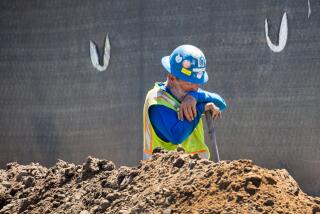‘Is It Hot Enough for You?’
- Share via
It’s summertime in Southern California and the mercury is inching almost as high as the electricity rates. You’re probably being a good little sweatmeister, conserving energy by using fans instead of air conditioning.
Click wants to help in the power crisis, so here are a few sites guaranteed to make you feel as though L.A. is indeed a cool place.
We’ll start our hot-spot tour with Death Valley (https://www.nps.gov/deva), where summer temps often top 120 degrees. That pretty much scares away everything but a few hardy lizards and German tourists. Just remember, it’s a dry heat.
But we can do better than that. How about heat and noxious fumes? Centralia, Pa. (https://www.centraliapa.com), or what’s left of it, has been sitting on top of burning coal mines since 1962. The fire started in the town dump and spread into the mines. Sulfur rises to the surface with steam. Smoke is coming out of the ground in the graveyard. Signs warn of toxic gases. Snow never sticks because the ground is so warm. So are you going to complain about a smog alert?
The National Climate Data Center (https://www.ncdc.noaa.gov/ol/climate/severeweather/temperatures.html) tells us that the hottest temperature ever recorded in the United States was in California: 134 degrees in Greenland Ranch, which probably wasn’t green for long. We couldn’t find Greenland Ranch on an atlas, but it looks to be right around Death Valley on the NCDC map. Death Valley often is called the hottest place on Earth.
But so is Dallol, Ethiopia (https://www.wxdude.com/page14.html), where the average temperature is 94 degrees. Riyadh, Saudi Arabia (https://weather.noaa.gov/weather/current/OERY.html), sometimes gets the title too, although we don’t know how hot any place can be that bans liquor.
Australia definitely doesn’t ban liquor, and it has a lot of desert outback. Marble Bar, without a Foster’s in sight, is considered Oz’s hottest place (https://www.osa.com.au/~shaun/outback/bs2000-090.html). December sees 20 days with temps over 105, but then that’s summer down there.
Normally considered a chill zone, Alaska has hit 100 degrees (https://home.gci.net/~rogers/ACCL/alaska.htm). The mosquitoes must have been the size of fruit bats that summer.
But it’s heat and humidity that really make things special. That could be pretty much anywhere in the Midwest, but we’ll go south to Miami (https://www.swfloridaonline.com). People who live in Miami generally swim in the ocean only during the summer, when the water is in the 80s. They say it’s too cold in winter (70s). We think they just don’t realize they’re swimming. By the time August rolls around, you need special instruments just to tell the difference between air and water.
For really hot water, there are the mud volcanoes, geysers and hot springs at Yellowstone (https://www.yellowstonenationalpark.com/mudvolcano.htm). In Black Dragon’s Caldron, the water runs 191 degrees. Plus the summer crowds will remind you of the 405 at 6 p.m.
To see where it is the hottest (and chilliest) right now, you can visit WeatherMatrix (https://www.weathermatrix.net/weather/extreme.shtml). Death Valley wins again, but Fort Worth was in the running.
We guarantee that in either of those places, some bozo will ask, “Is it hotenough for you?”
Next time tell them you prefer the lava flows of Kilauea volcano in Hawaii (https://eos.pgd.hawaii.edu/ppages/kil.html), where the temperatures reach 2,102 degrees Fahrenheit.
You could fry an egg on that, but probably not sunny-side up.
*
Connect: Check out past columns at www.latimes.com/click
More to Read
Sign up for The Wild
We’ll help you find the best places to hike, bike and run, as well as the perfect silent spots for meditation and yoga.
You may occasionally receive promotional content from the Los Angeles Times.






